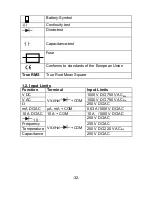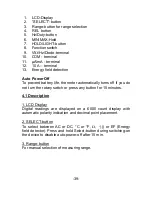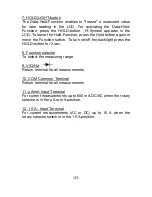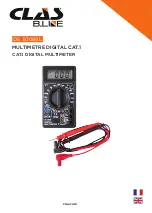
To measure current, break the circuit and connect the probes to
two circuit connection points. Never connect the probes across a
voltage source in parallel. Doing so can blow the fuse or damage
the circuit under test.
Note:
The maximum input current is 600 mA or 10 A depending
on the terminal used. In these ranges excessive current blows
the fuses, which you must replace.
1. Set the rotary selector to the µA/mA range. If you do not
know the current level, set it to the highest position and
reduce the setting as needed to get a reading.
2. Press SELECT to select between DC and AC.
3. Plug the black test lead into your m
eter’s COM terminal and
the red test lead into your meter’s µA/mA or 10 A terminal.
4. Remove power from the circuit under test and then break
the circuit at the appropriate point.
5. Connect the test leads in series with the circuit.
6. Apply power and read the current. Your meter displays the
current value.
Note:
If you see the meter for DC current, “-” appears or
disappears. This indicates the polarity of the measured current.
6.3. Measuring Resistance
WARNING!
* Never connect the test leads to a source of voltage when
you have the selected the OHMS function and plugged the
test leads into the V/
/Hz/ -terminal.
-45-









































